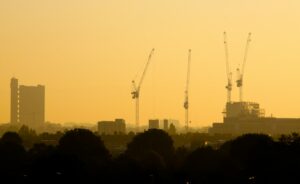DEFRA has published the annual Emissions of air pollutants in the UK figures and, while the trend for most major sources of air pollution is downwards, domestic wood burning is once again under the spotlight.
The emissions covered in these figures are particulate matter (PM10 and PM2.5), nitrogen oxides, ammonia, non-methane volatile organic compounds and sulphur dioxide.
Between 2005 and 2022 the UK met its emission reduction commitment to all the above pollutants. Shown below is the target for 2022, the reduction that was actually achieved and what that reduction needs have grown to by 2030
Ammonia: 2022 target: 8% • Achieved: 12% • 2030 target: 16%
NMVOCs: 2022 target 32% • Achieved: 44% • 2030 target: 39%
Nitrogen oxides: 2022 target 55% • Achieved: 63% reduction • 2030 target: 73%
PM2.5: 2022 target 30% • Achieved: 42% • 2030 target: 46%
Sulphur dioxide: 2022 target 59% • Achieved: 85% • 2030 target: 88%
The UK does not have emission reduction commitments for PM10.
Nitrogen oxides (mostly from road transport and energy) and Sulphur dioxide (mostly from energy and industrial combustion) emissions have been reduced most dramatically since 2005 but the rate of reduction is slowing down notably.
Emissions from agriculture contributed 87% of total ammonia emissions in 2022 a slight increase since 2010, partly because of variations in weather conditions affecting crop planting and fertiliser use.
By 2012 NMVOC emissions (domestic solvents being the worst single source) had already been drastically reduced from their 1970 levels. Tougher regulations has seen the contribution from transport fall from 33% in 1990 to just 4% in 2022, while emissions from Scotch whisky production have increased by 98% since 1990.
PM2.5 emissions have been falling since 1970, thanks to the reduction in the use of coal and improved emission standards for transport but, over recent years, the rate of change has reduced. Compared to earlier decades, emission levels have been relatively steady, with small annual fluctuations.
The report observes that decreases in emissions from other sources have been largely offset by increases in emissions from domestic wood burning.
It states: ‘Domestic combustion covers households burning a variety of fuels including wood, coal, solid smokeless fuels, and fuels derived from waste such as coffee logs. This was a major source of PM emissions in 2022, as it contributed 29% of total PM2.5 emissions and 15% of total PM10 emissions.
‘Most emissions from this source come from households burning wood in stoves and open fires. The use of wood as a fuel contributed 75% of both total PM2.5 and PM10 emissions from domestic combustion in 2022.
‘Domestic combustion of wood contributed 22% of overall PM2.5 emissions and 11% of overall PM10 emissions in 2022.
‘Emissions of PM2.5 and PM10 from domestic wood burning increased by 56% between 2012 and 2022.
‘In the 1970s, 1980s and 1990s, coal combustion was the primary source of PM emissions from households; yet the use of coal as a fuel has fallen over time (in 2022 the combustion of coal contributed 12% of PM2.5 emissions from domestic combustion).’
The full reports can be accessed here

















Why no mention of the much larger contribution to pm concentrations made by those ammonia emissions? Ammonia from farming emissions is the largest source of secondary pm, and it’s contribution to total pm dwarfs the contribution of wood burners. However even the governments own info pages on this fail to apportion the pm to ammonia, lumping it into an ‘other’ category, it’s a bit fishy. Agricultural emissions are far more to blame for pm than domestic wood burning, the data for which is shonky at best, mainly coming from market research surveys. I feel agriculture is being protected and wood burning is the scapegoat
Energy costs for clean fuels like electricity are too high. It can cost more to charge an electric car especially if you are away from home; similarly heating the house. If you live in the countryside in an older house a fire is necessary to keep warm; it will be a sad day when fires are banned in rural areas. Urban and rural living need different rules. The village pub is not the same without a cosy log fire.
Yes, cosy and maybe fine as long as you are not sending your smoke to your neighbours? That can be the case even in a rural setting and, I can assure you, it is absolute misery to live next door to someone who burns goodness knows what all winter and thinks it’s alright because it’s in the countryside. Same with neighnour’s bonfires almost under your window too. Shutting one’s own windows does not keep their smoke out. I think that’s plain selfish but of course, there they are all cosy and snug indoors and don’t believe you when you say politely please can you stop the smoke or at least reduce it..For those of us who suffer in this way it would be a happy day, not a sad one, when fires are banned in rural areas. But we know that won’t happen. Perhaps the answer is to be more considerate and ask your neighbours if your smoke if making them ill? And to try not to make too much smoke? Thank you.
This is the nonsense of constantly debating the national % figure. The industry are happy to do this as it is a perpetual distraction from the real issue, and that is the huge pollution hotspots that newly installed stoves create for neighbours where there was previously no solid fuel burning at all.
There needs to be a phased ban managed by national government starting with a ban on new installs in on the grid properties, and graduating to a full ban with assistance for those that genuinely are either in fuel poverty or genuinely remote areas. Nobody should be subject to a stove pollution lottery based on how knowledgeable their council is or not on the subject, particularly when in the vast majority of cased it is HETAS providing the “knowledge” endorsed by DEFRA.
Shocking, isn’t it? And probably even more now in 2024. And yet the Stove Industry Alliance and the stove retailers continue to tell us all is fine (yes!) and good – and “clean” (ish …). When they claim the new better stoves emit UP TO 80% less fine particulate emissions compared to open fires or older stoves, that could mean next to nothing, just 1% even, when you think about it … I rang around a few friends and family members today and I would say 1 in 5 now have wood stoves, so I think there are far more in the UK thab the 1.5 million that we are told. Does anyone here know? When some individuals buy “cleaner” new stoves, they sell the old “dirtier” ones on the second hand market. That 56% is a lot, especially compared to the decrease in coal. At this rate, wood stoves will have to be banned before long, except for families who genuinely (and unfortunately) have no other way to keep warm. But what affordable alternatives are there? Heat pumps are expensive.